Comparing Erikson's Psychosocial and Bowlby's Attachment Theory
VerifiedAdded on 2022/11/29
|6
|1604
|423
Essay
AI Summary
This essay provides a comparative analysis of Erik Erikson's Psychosocial Theory and John Bowlby's Attachment Theory, both of which are pivotal in understanding child development. Erikson's theory posits eight stages of psychosocial development, each marked by a crisis that shapes personality, with a strong emphasis on the development of trust and a healthy sense of self. Bowlby's theory focuses on the innate human need to form attachments, particularly in infancy, emphasizing the importance of a secure base provided by caregivers for exploration and future relationships. The essay highlights the similarities between the two theories, particularly in the importance of trust and the impact of early relationships on later development, while also acknowledging their distinct focuses. Erikson's theory emphasizes ego development through stages, and Bowlby's theory emphasizes the enduring nature of attachment bonds and the influence of caregiver responsiveness on a child's sense of security and future relationships. The essay references key concepts such as social releasers, secure base, and the impact of consistent care on a child's ability to trust and navigate their environment. The essay synthesizes the core tenets of both theories to provide a comprehensive understanding of their contributions to developmental psychology.
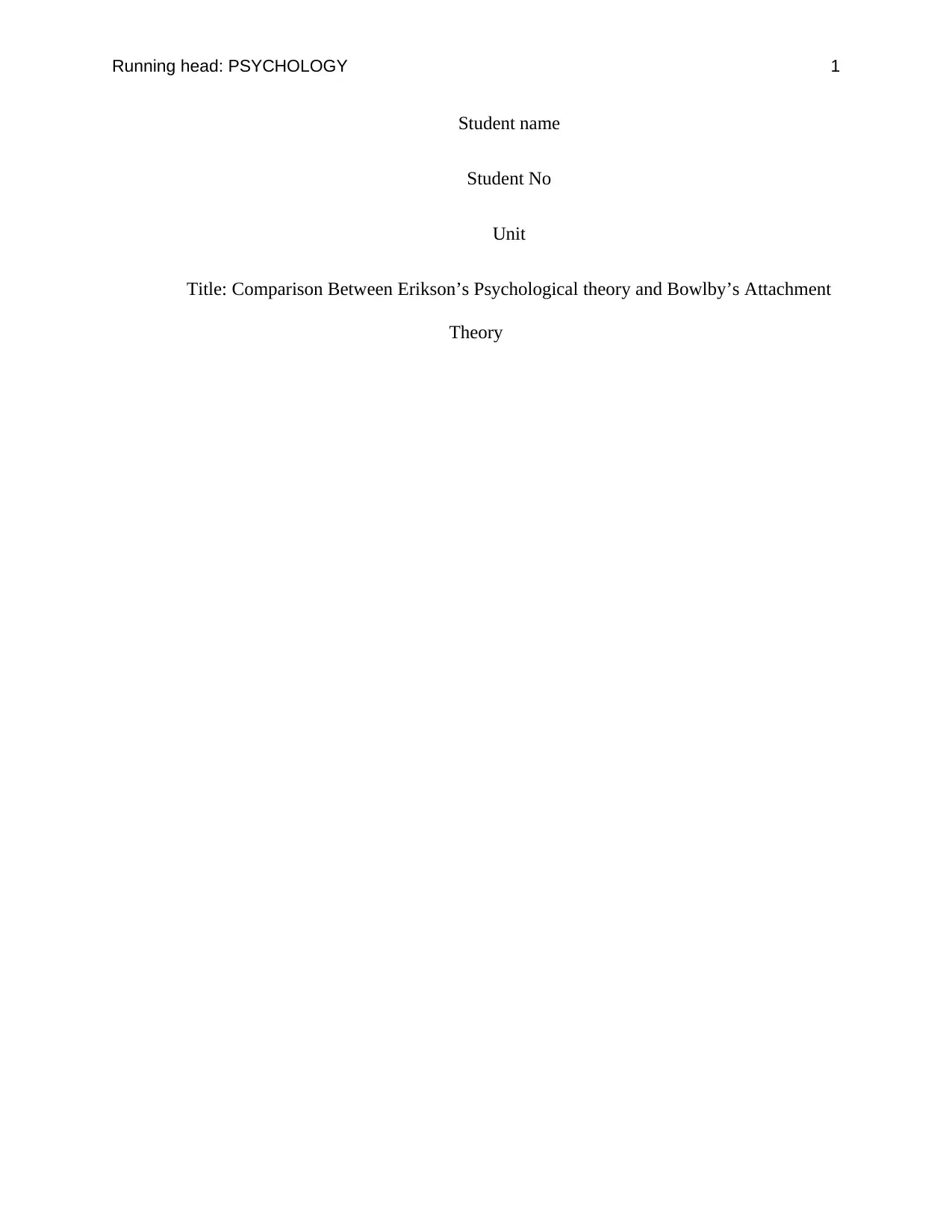
Running head: PSYCHOLOGY 1
Student name
Student No
Unit
Title: Comparison Between Erikson’s Psychological theory and Bowlby’s Attachment
Theory
Student name
Student No
Unit
Title: Comparison Between Erikson’s Psychological theory and Bowlby’s Attachment
Theory
Paraphrase This Document
Need a fresh take? Get an instant paraphrase of this document with our AI Paraphraser
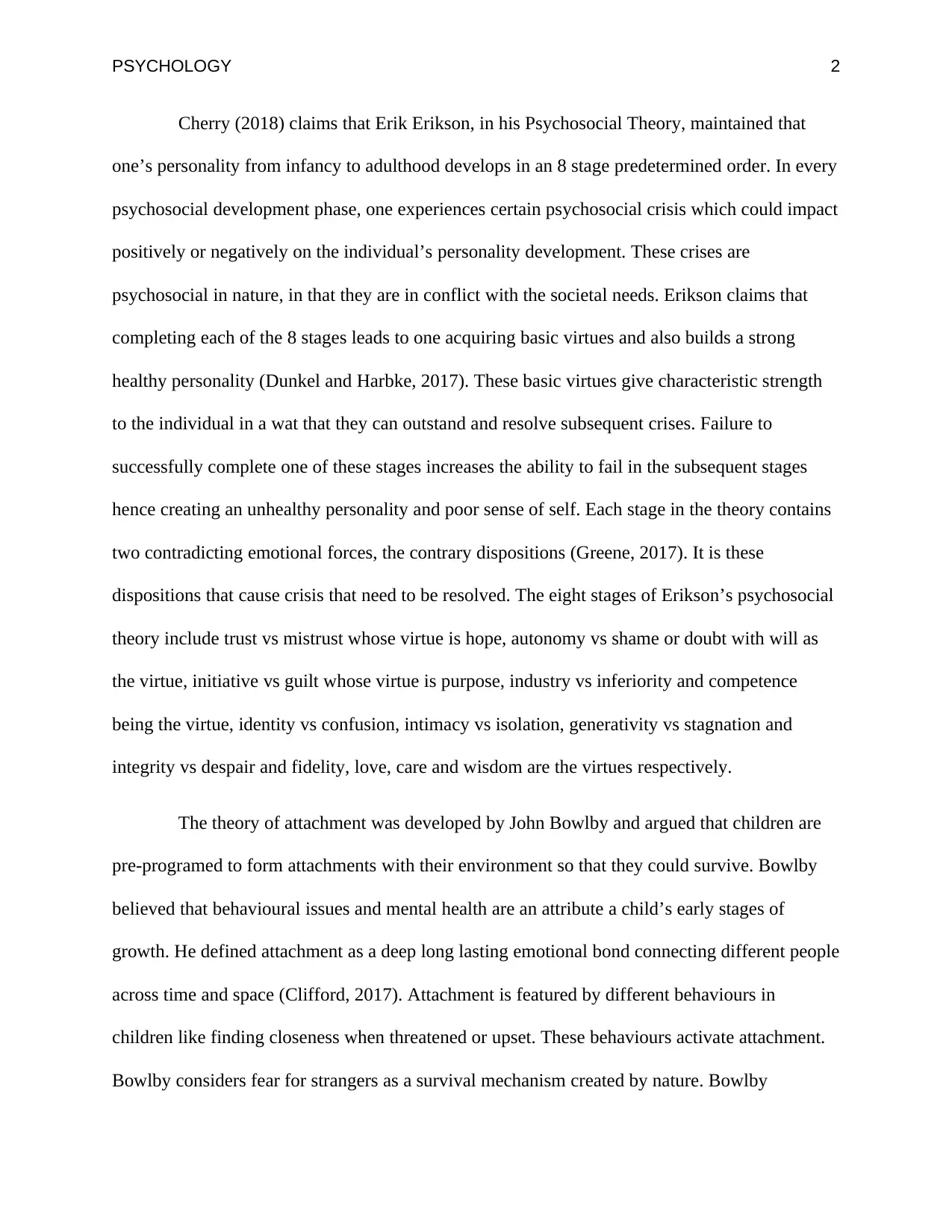
PSYCHOLOGY 2
Cherry (2018) claims that Erik Erikson, in his Psychosocial Theory, maintained that
one’s personality from infancy to adulthood develops in an 8 stage predetermined order. In every
psychosocial development phase, one experiences certain psychosocial crisis which could impact
positively or negatively on the individual’s personality development. These crises are
psychosocial in nature, in that they are in conflict with the societal needs. Erikson claims that
completing each of the 8 stages leads to one acquiring basic virtues and also builds a strong
healthy personality (Dunkel and Harbke, 2017). These basic virtues give characteristic strength
to the individual in a wat that they can outstand and resolve subsequent crises. Failure to
successfully complete one of these stages increases the ability to fail in the subsequent stages
hence creating an unhealthy personality and poor sense of self. Each stage in the theory contains
two contradicting emotional forces, the contrary dispositions (Greene, 2017). It is these
dispositions that cause crisis that need to be resolved. The eight stages of Erikson’s psychosocial
theory include trust vs mistrust whose virtue is hope, autonomy vs shame or doubt with will as
the virtue, initiative vs guilt whose virtue is purpose, industry vs inferiority and competence
being the virtue, identity vs confusion, intimacy vs isolation, generativity vs stagnation and
integrity vs despair and fidelity, love, care and wisdom are the virtues respectively.
The theory of attachment was developed by John Bowlby and argued that children are
pre-programed to form attachments with their environment so that they could survive. Bowlby
believed that behavioural issues and mental health are an attribute a child’s early stages of
growth. He defined attachment as a deep long lasting emotional bond connecting different people
across time and space (Clifford, 2017). Attachment is featured by different behaviours in
children like finding closeness when threatened or upset. These behaviours activate attachment.
Bowlby considers fear for strangers as a survival mechanism created by nature. Bowlby
Cherry (2018) claims that Erik Erikson, in his Psychosocial Theory, maintained that
one’s personality from infancy to adulthood develops in an 8 stage predetermined order. In every
psychosocial development phase, one experiences certain psychosocial crisis which could impact
positively or negatively on the individual’s personality development. These crises are
psychosocial in nature, in that they are in conflict with the societal needs. Erikson claims that
completing each of the 8 stages leads to one acquiring basic virtues and also builds a strong
healthy personality (Dunkel and Harbke, 2017). These basic virtues give characteristic strength
to the individual in a wat that they can outstand and resolve subsequent crises. Failure to
successfully complete one of these stages increases the ability to fail in the subsequent stages
hence creating an unhealthy personality and poor sense of self. Each stage in the theory contains
two contradicting emotional forces, the contrary dispositions (Greene, 2017). It is these
dispositions that cause crisis that need to be resolved. The eight stages of Erikson’s psychosocial
theory include trust vs mistrust whose virtue is hope, autonomy vs shame or doubt with will as
the virtue, initiative vs guilt whose virtue is purpose, industry vs inferiority and competence
being the virtue, identity vs confusion, intimacy vs isolation, generativity vs stagnation and
integrity vs despair and fidelity, love, care and wisdom are the virtues respectively.
The theory of attachment was developed by John Bowlby and argued that children are
pre-programed to form attachments with their environment so that they could survive. Bowlby
believed that behavioural issues and mental health are an attribute a child’s early stages of
growth. He defined attachment as a deep long lasting emotional bond connecting different people
across time and space (Clifford, 2017). Attachment is featured by different behaviours in
children like finding closeness when threatened or upset. These behaviours activate attachment.
Bowlby considers fear for strangers as a survival mechanism created by nature. Bowlby
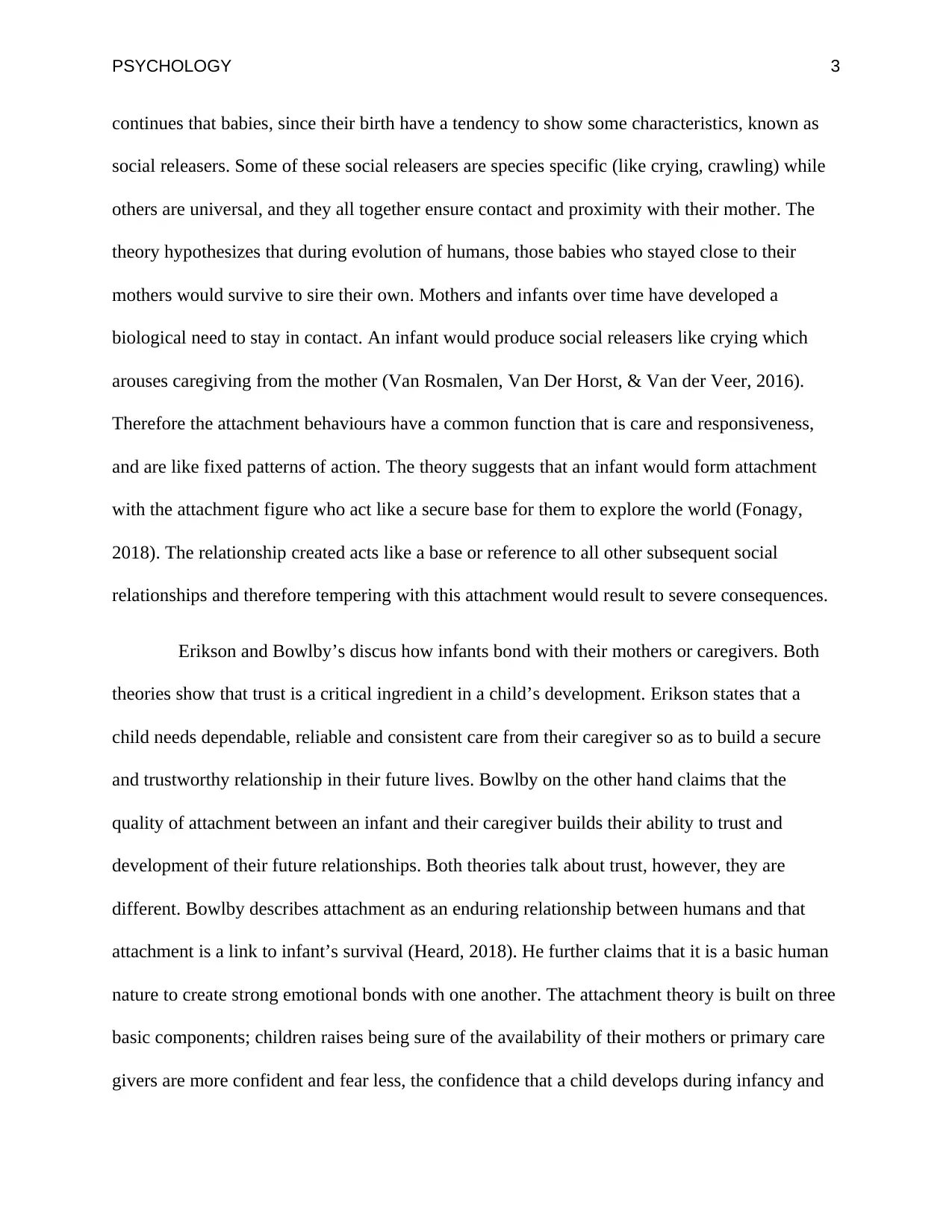
PSYCHOLOGY 3
continues that babies, since their birth have a tendency to show some characteristics, known as
social releasers. Some of these social releasers are species specific (like crying, crawling) while
others are universal, and they all together ensure contact and proximity with their mother. The
theory hypothesizes that during evolution of humans, those babies who stayed close to their
mothers would survive to sire their own. Mothers and infants over time have developed a
biological need to stay in contact. An infant would produce social releasers like crying which
arouses caregiving from the mother (Van Rosmalen, Van Der Horst, & Van der Veer, 2016).
Therefore the attachment behaviours have a common function that is care and responsiveness,
and are like fixed patterns of action. The theory suggests that an infant would form attachment
with the attachment figure who act like a secure base for them to explore the world (Fonagy,
2018). The relationship created acts like a base or reference to all other subsequent social
relationships and therefore tempering with this attachment would result to severe consequences.
Erikson and Bowlby’s discus how infants bond with their mothers or caregivers. Both
theories show that trust is a critical ingredient in a child’s development. Erikson states that a
child needs dependable, reliable and consistent care from their caregiver so as to build a secure
and trustworthy relationship in their future lives. Bowlby on the other hand claims that the
quality of attachment between an infant and their caregiver builds their ability to trust and
development of their future relationships. Both theories talk about trust, however, they are
different. Bowlby describes attachment as an enduring relationship between humans and that
attachment is a link to infant’s survival (Heard, 2018). He further claims that it is a basic human
nature to create strong emotional bonds with one another. The attachment theory is built on three
basic components; children raises being sure of the availability of their mothers or primary care
givers are more confident and fear less, the confidence that a child develops during infancy and
continues that babies, since their birth have a tendency to show some characteristics, known as
social releasers. Some of these social releasers are species specific (like crying, crawling) while
others are universal, and they all together ensure contact and proximity with their mother. The
theory hypothesizes that during evolution of humans, those babies who stayed close to their
mothers would survive to sire their own. Mothers and infants over time have developed a
biological need to stay in contact. An infant would produce social releasers like crying which
arouses caregiving from the mother (Van Rosmalen, Van Der Horst, & Van der Veer, 2016).
Therefore the attachment behaviours have a common function that is care and responsiveness,
and are like fixed patterns of action. The theory suggests that an infant would form attachment
with the attachment figure who act like a secure base for them to explore the world (Fonagy,
2018). The relationship created acts like a base or reference to all other subsequent social
relationships and therefore tempering with this attachment would result to severe consequences.
Erikson and Bowlby’s discus how infants bond with their mothers or caregivers. Both
theories show that trust is a critical ingredient in a child’s development. Erikson states that a
child needs dependable, reliable and consistent care from their caregiver so as to build a secure
and trustworthy relationship in their future lives. Bowlby on the other hand claims that the
quality of attachment between an infant and their caregiver builds their ability to trust and
development of their future relationships. Both theories talk about trust, however, they are
different. Bowlby describes attachment as an enduring relationship between humans and that
attachment is a link to infant’s survival (Heard, 2018). He further claims that it is a basic human
nature to create strong emotional bonds with one another. The attachment theory is built on three
basic components; children raises being sure of the availability of their mothers or primary care
givers are more confident and fear less, the confidence that a child develops during infancy and
⊘ This is a preview!⊘
Do you want full access?
Subscribe today to unlock all pages.

Trusted by 1+ million students worldwide

PSYCHOLOGY 4
childhood period remains unchanged throughout one’s life and that the child expect their mother
or caregiver to remain responsive. Erikson in his theory focuses on one’s ego through the eight
developmental stages. In the first stage, trust vs mistrust, it is when the child learns to trust their
mother so as to meet the infant’s basic wants. This makes the child feel protected and secure
even during times of uncertainty. Success of this stage builds a virtue of hope in the infant and
they are able to trust somebody to help them in case of any crisis. If the development of this
stage fails, the child develops fear and mistrust. This also affect the safe development of the
other seven stages.
Kerpelman and Pittman (2018) claim that Erikson’s and Bowlby’s theories are parallel
in that they both offer opportunities and concepts to build the application of each other. A child’s
attachment history is taken to form the basis of their identity. Kerpelman and Pittman (2018)
argue that the identity formation within a child is more of a co-construction with help from the
care giver but not the child accomplishment. There are therefore more similarities between these
two theories as pertaining development of infants, although they have different bases. Bowlby’s
attachment theory claims that it is through interaction with a caregiver that a child develops self
and models of the world. A successful model builds a secure attachment while a negative model
gives a poor attachment. Available and sensitive caregivers during crisis encourage positive
attachment (Fonagy, Luyten, Allison, & Campbell, 2018). The child develops a feeling of
worthiness due to trust that somebody care and protects them. The child uses the social releasers
so as to explore their environment. When the response to the social releasers are a success and as
per the child’s expectations, they grow more trust and confidence about the environment.
In the first stage of Erikson’s Psychological theory, an infant is not certain of their
environment and therefore depend on their mother or caregiver for consistency and stability of
childhood period remains unchanged throughout one’s life and that the child expect their mother
or caregiver to remain responsive. Erikson in his theory focuses on one’s ego through the eight
developmental stages. In the first stage, trust vs mistrust, it is when the child learns to trust their
mother so as to meet the infant’s basic wants. This makes the child feel protected and secure
even during times of uncertainty. Success of this stage builds a virtue of hope in the infant and
they are able to trust somebody to help them in case of any crisis. If the development of this
stage fails, the child develops fear and mistrust. This also affect the safe development of the
other seven stages.
Kerpelman and Pittman (2018) claim that Erikson’s and Bowlby’s theories are parallel
in that they both offer opportunities and concepts to build the application of each other. A child’s
attachment history is taken to form the basis of their identity. Kerpelman and Pittman (2018)
argue that the identity formation within a child is more of a co-construction with help from the
care giver but not the child accomplishment. There are therefore more similarities between these
two theories as pertaining development of infants, although they have different bases. Bowlby’s
attachment theory claims that it is through interaction with a caregiver that a child develops self
and models of the world. A successful model builds a secure attachment while a negative model
gives a poor attachment. Available and sensitive caregivers during crisis encourage positive
attachment (Fonagy, Luyten, Allison, & Campbell, 2018). The child develops a feeling of
worthiness due to trust that somebody care and protects them. The child uses the social releasers
so as to explore their environment. When the response to the social releasers are a success and as
per the child’s expectations, they grow more trust and confidence about the environment.
In the first stage of Erikson’s Psychological theory, an infant is not certain of their
environment and therefore depend on their mother or caregiver for consistency and stability of
Paraphrase This Document
Need a fresh take? Get an instant paraphrase of this document with our AI Paraphraser
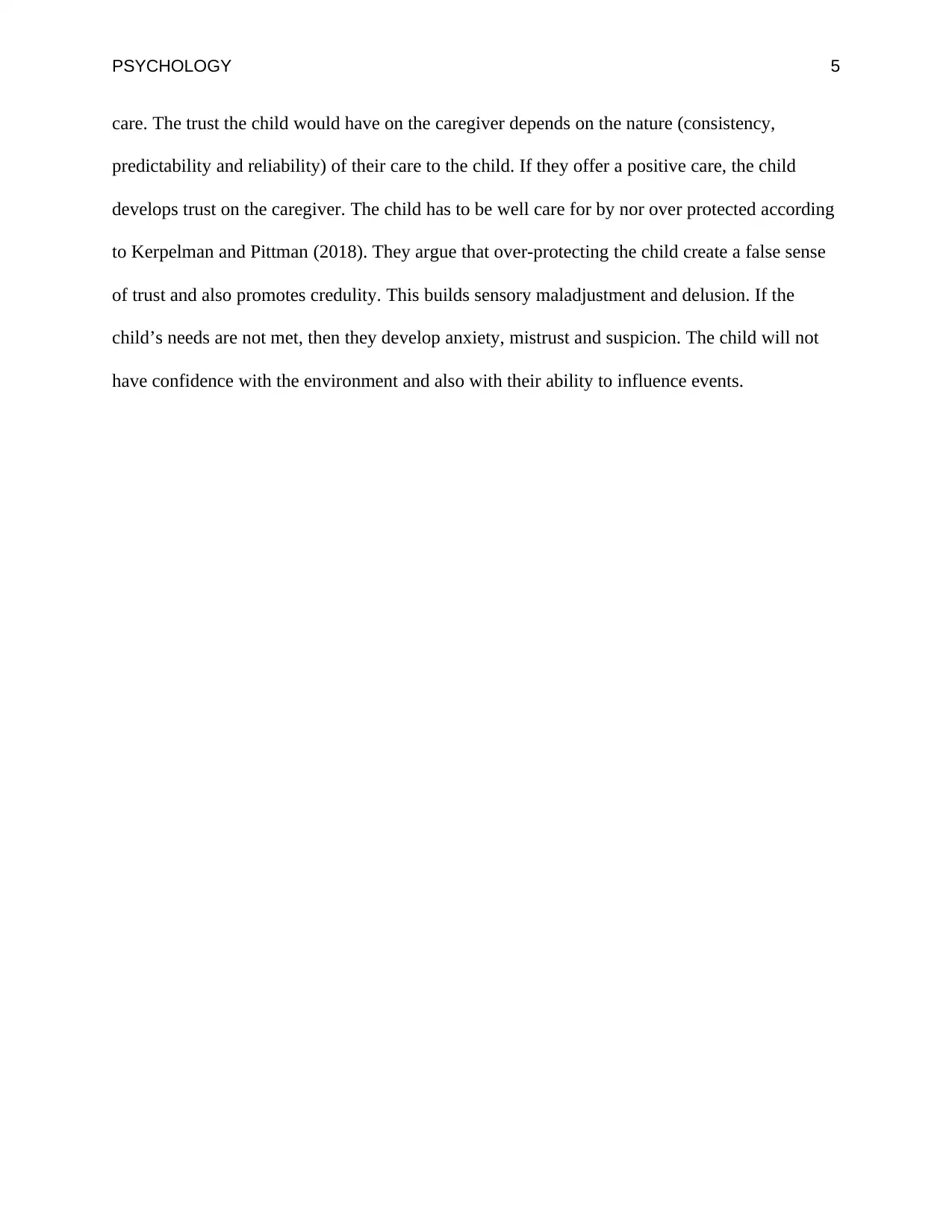
PSYCHOLOGY 5
care. The trust the child would have on the caregiver depends on the nature (consistency,
predictability and reliability) of their care to the child. If they offer a positive care, the child
develops trust on the caregiver. The child has to be well care for by nor over protected according
to Kerpelman and Pittman (2018). They argue that over-protecting the child create a false sense
of trust and also promotes credulity. This builds sensory maladjustment and delusion. If the
child’s needs are not met, then they develop anxiety, mistrust and suspicion. The child will not
have confidence with the environment and also with their ability to influence events.
care. The trust the child would have on the caregiver depends on the nature (consistency,
predictability and reliability) of their care to the child. If they offer a positive care, the child
develops trust on the caregiver. The child has to be well care for by nor over protected according
to Kerpelman and Pittman (2018). They argue that over-protecting the child create a false sense
of trust and also promotes credulity. This builds sensory maladjustment and delusion. If the
child’s needs are not met, then they develop anxiety, mistrust and suspicion. The child will not
have confidence with the environment and also with their ability to influence events.
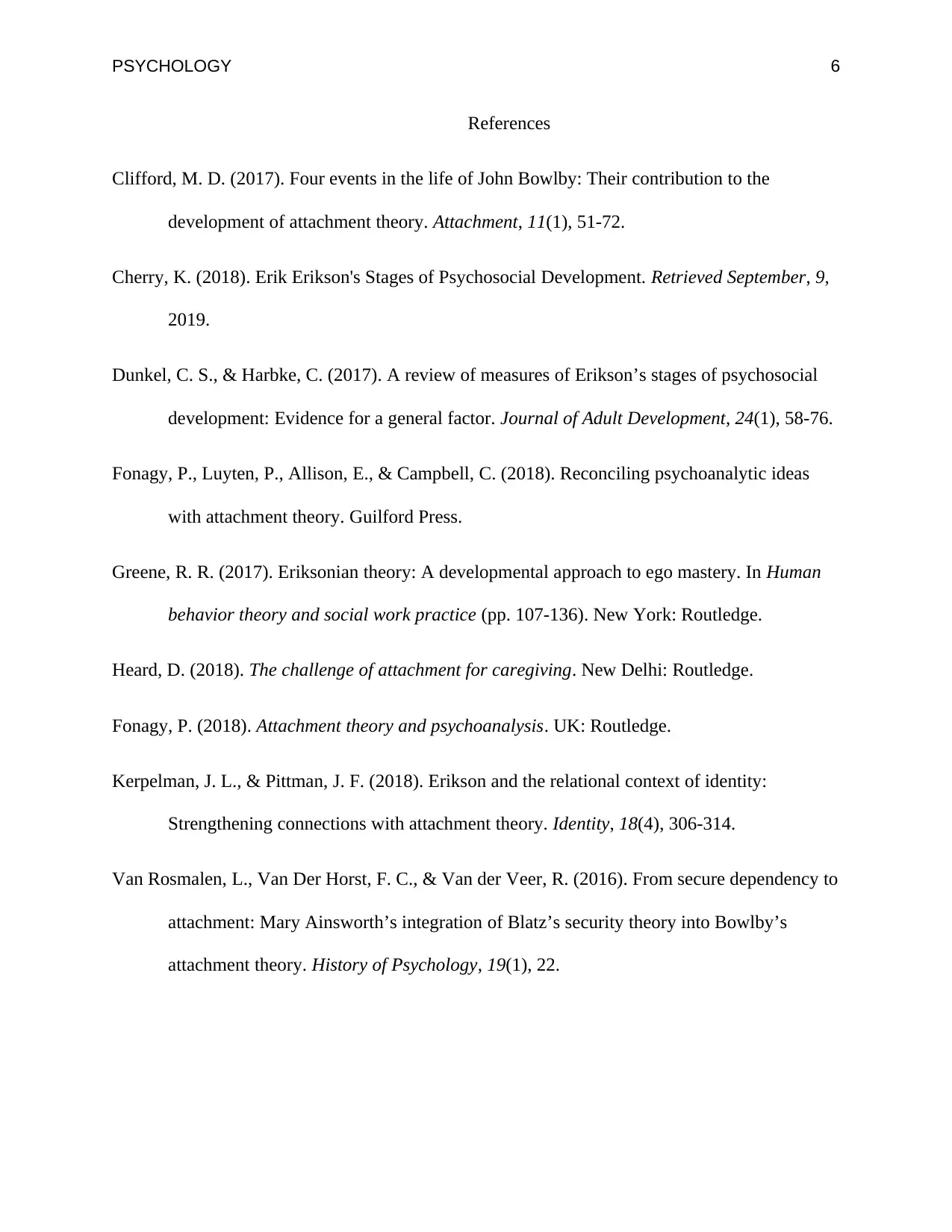
PSYCHOLOGY 6
References
Clifford, M. D. (2017). Four events in the life of John Bowlby: Their contribution to the
development of attachment theory. Attachment, 11(1), 51-72.
Cherry, K. (2018). Erik Erikson's Stages of Psychosocial Development. Retrieved September, 9,
2019.
Dunkel, C. S., & Harbke, C. (2017). A review of measures of Erikson’s stages of psychosocial
development: Evidence for a general factor. Journal of Adult Development, 24(1), 58-76.
Fonagy, P., Luyten, P., Allison, E., & Campbell, C. (2018). Reconciling psychoanalytic ideas
with attachment theory. Guilford Press.
Greene, R. R. (2017). Eriksonian theory: A developmental approach to ego mastery. In Human
behavior theory and social work practice (pp. 107-136). New York: Routledge.
Heard, D. (2018). The challenge of attachment for caregiving. New Delhi: Routledge.
Fonagy, P. (2018). Attachment theory and psychoanalysis. UK: Routledge.
Kerpelman, J. L., & Pittman, J. F. (2018). Erikson and the relational context of identity:
Strengthening connections with attachment theory. Identity, 18(4), 306-314.
Van Rosmalen, L., Van Der Horst, F. C., & Van der Veer, R. (2016). From secure dependency to
attachment: Mary Ainsworth’s integration of Blatz’s security theory into Bowlby’s
attachment theory. History of Psychology, 19(1), 22.
References
Clifford, M. D. (2017). Four events in the life of John Bowlby: Their contribution to the
development of attachment theory. Attachment, 11(1), 51-72.
Cherry, K. (2018). Erik Erikson's Stages of Psychosocial Development. Retrieved September, 9,
2019.
Dunkel, C. S., & Harbke, C. (2017). A review of measures of Erikson’s stages of psychosocial
development: Evidence for a general factor. Journal of Adult Development, 24(1), 58-76.
Fonagy, P., Luyten, P., Allison, E., & Campbell, C. (2018). Reconciling psychoanalytic ideas
with attachment theory. Guilford Press.
Greene, R. R. (2017). Eriksonian theory: A developmental approach to ego mastery. In Human
behavior theory and social work practice (pp. 107-136). New York: Routledge.
Heard, D. (2018). The challenge of attachment for caregiving. New Delhi: Routledge.
Fonagy, P. (2018). Attachment theory and psychoanalysis. UK: Routledge.
Kerpelman, J. L., & Pittman, J. F. (2018). Erikson and the relational context of identity:
Strengthening connections with attachment theory. Identity, 18(4), 306-314.
Van Rosmalen, L., Van Der Horst, F. C., & Van der Veer, R. (2016). From secure dependency to
attachment: Mary Ainsworth’s integration of Blatz’s security theory into Bowlby’s
attachment theory. History of Psychology, 19(1), 22.
⊘ This is a preview!⊘
Do you want full access?
Subscribe today to unlock all pages.

Trusted by 1+ million students worldwide
1 out of 6
Your All-in-One AI-Powered Toolkit for Academic Success.
+13062052269
info@desklib.com
Available 24*7 on WhatsApp / Email
![[object Object]](/_next/static/media/star-bottom.7253800d.svg)
Unlock your academic potential
Copyright © 2020–2025 A2Z Services. All Rights Reserved. Developed and managed by ZUCOL.

